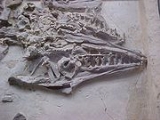
Pythonomorpha
Encyclopedia
Pythonomorpha was originally proposed by paleontologist Edward Drinker Cope
(1869) as a reptilian order comprising snake
s and mosasaurs. Cope wrote, "In the mosasauroids, we almost realize the fictions of snake-like dragon
s and sea-serpents, in which men have been ever prone to indulge. On account of the ophidian part of their affinities, I have called this order Pythonomorpha." However, the category was rejected by most 20th-Century herpetologists and paleontologists , who sought, instead, to demonstrate a close relationship between mosasaurs and varanid (monitor) lizards and who generally considered snakes to have evolved from terrestrial
, burrowing lizards (see, for example, Russell, 1967). Recently, though, Cope's Pythonomorpha has been revised and resurrected by a number of paleontologists (Lee, 1997; Caldwell et Lee, 1997) who have conducted extensive cladistic analyses which seem to show that snakes and mosasaurs may be more closely related to one another than either is to the varanid lizards and that snakes more likely arose from aquatic ancestors. As redefined by Lee (1997), the monophyletic Pythonomorpha consists of "The most recent common ancestor of mosasauroids and snakes, and all its descendants." This includes the aigialosaurs, dolichosaurs, coniasaurs, mosasaurs, and all snakes. Lee (1997) was able to show no less than 38 synapomorphies supporting Pythonomorpha.
The etymology of the term Pythonomorpha comes from the Greek
Python (a monstrous snake from Greek mythology
) and morphe ("form"), and refers to the generally serpentine body plan of members of the clade
.
Edward Drinker Cope
Edward Drinker Cope was an American paleontologist and comparative anatomist, as well as a noted herpetologist and ichthyologist. Born to a wealthy Quaker family, Cope distinguished himself as a child prodigy interested in science; he published his first scientific paper at the age of nineteen...
(1869) as a reptilian order comprising snake
Snake
Snakes are elongate, legless, carnivorous reptiles of the suborder Serpentes that can be distinguished from legless lizards by their lack of eyelids and external ears. Like all squamates, snakes are ectothermic, amniote vertebrates covered in overlapping scales...
s and mosasaurs. Cope wrote, "In the mosasauroids, we almost realize the fictions of snake-like dragon
Dragon
A dragon is a legendary creature, typically with serpentine or reptilian traits, that feature in the myths of many cultures. There are two distinct cultural traditions of dragons: the European dragon, derived from European folk traditions and ultimately related to Greek and Middle Eastern...
s and sea-serpents, in which men have been ever prone to indulge. On account of the ophidian part of their affinities, I have called this order Pythonomorpha." However, the category was rejected by most 20th-Century herpetologists and paleontologists , who sought, instead, to demonstrate a close relationship between mosasaurs and varanid (monitor) lizards and who generally considered snakes to have evolved from terrestrial
Terrestrial animal
Terrestrial animals are animals that live predominantly or entirely on land , as compared with aquatic animals, which live predominantly or entirely in the water , or amphibians, which rely on a combination of aquatic and terrestrial habitats...
, burrowing lizards (see, for example, Russell, 1967). Recently, though, Cope's Pythonomorpha has been revised and resurrected by a number of paleontologists (Lee, 1997; Caldwell et Lee, 1997) who have conducted extensive cladistic analyses which seem to show that snakes and mosasaurs may be more closely related to one another than either is to the varanid lizards and that snakes more likely arose from aquatic ancestors. As redefined by Lee (1997), the monophyletic Pythonomorpha consists of "The most recent common ancestor of mosasauroids and snakes, and all its descendants." This includes the aigialosaurs, dolichosaurs, coniasaurs, mosasaurs, and all snakes. Lee (1997) was able to show no less than 38 synapomorphies supporting Pythonomorpha.
The etymology of the term Pythonomorpha comes from the Greek
Greek language
Greek is an independent branch of the Indo-European family of languages. Native to the southern Balkans, it has the longest documented history of any Indo-European language, spanning 34 centuries of written records. Its writing system has been the Greek alphabet for the majority of its history;...
Python (a monstrous snake from Greek mythology
Greek mythology
Greek mythology is the body of myths and legends belonging to the ancient Greeks, concerning their gods and heroes, the nature of the world, and the origins and significance of their own cult and ritual practices. They were a part of religion in ancient Greece...
) and morphe ("form"), and refers to the generally serpentine body plan of members of the clade
Clade
A clade is a group consisting of a species and all its descendants. In the terms of biological systematics, a clade is a single "branch" on the "tree of life". The idea that such a "natural group" of organisms should be grouped together and given a taxonomic name is central to biological...
.

